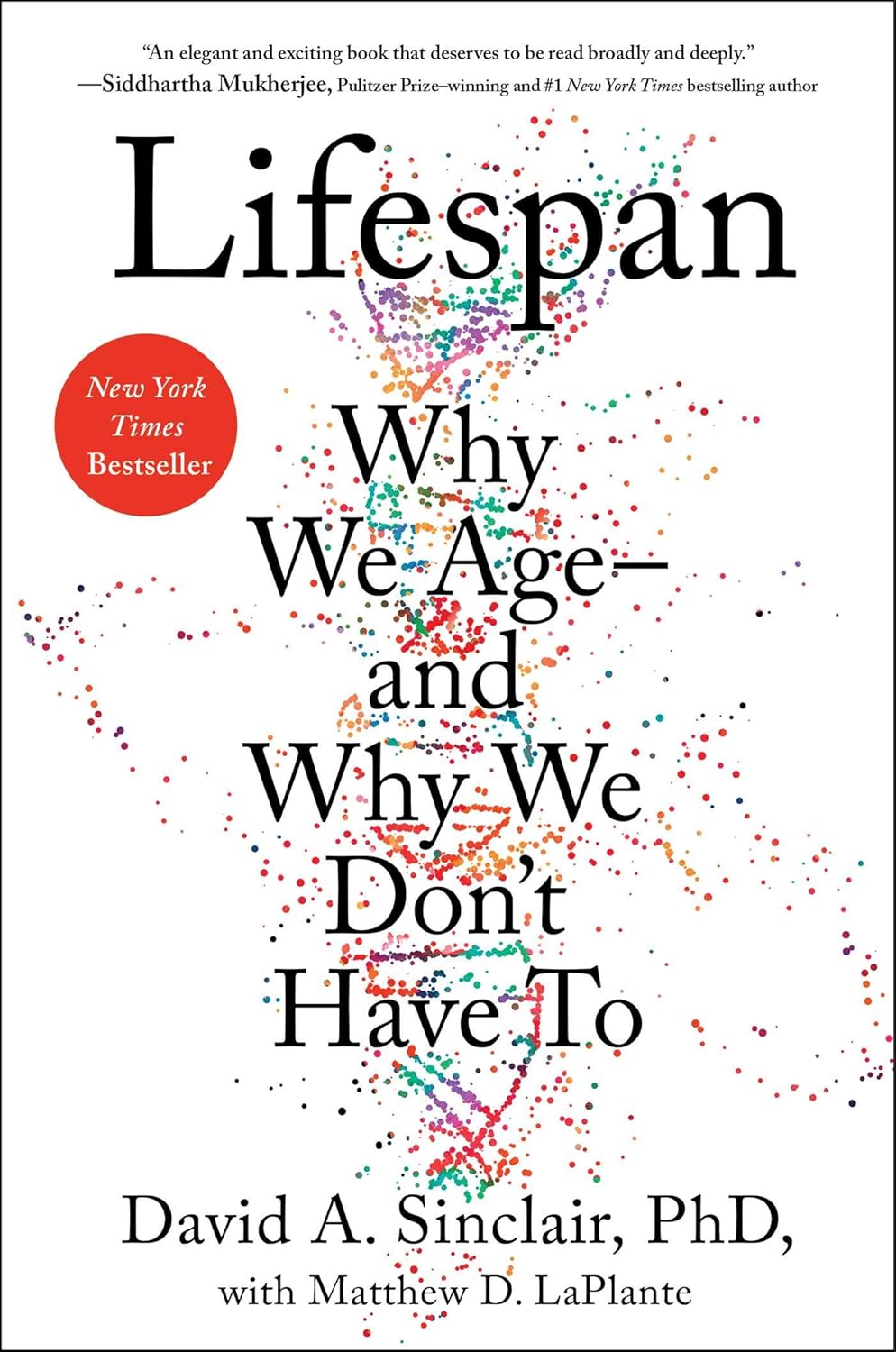Aging as a Disease
Dr. David A. Sinclair, our guide through this exciting terrain, asserts, "Aging is a disease, and that disease is treatable." Pause for a moment and let that sink in. We've been conditioned to accept aging as an irreversible part of life, yet Dr. Sinclair proposes that our bodies' gradual deterioration might indeed be a treatable condition, much like any other disease.
He draws attention to the way our cells age, lose efficiency, and become vulnerable to various ailments. Imagine if we could intervene in this process, not just to extend life, but to prolong vibrant, youthful health. Dr. Sinclair envisions a future where our bodies' natural defenses are fortified, enabling us to remain agile, energetic, and robust well into what was previously considered our "golden years."
But what evidence supports this audacious claim? The author sheds light on groundbreaking research and compelling studies that hint at the possibility of manipulating certain genes and cellular processes to counteract the aging process. He quotes from scientists who have delved deep into the mechanisms behind cellular decline:
"Since 1991, when the first of my papers about aging and DNA repair was published, many other laboratories have replicated and extended the original observations, proving that the DNA damage theory of aging is now a widely accepted explanation of why we grow old."
This is a scientific endeavor with years of careful research behind it; it is not just wishful thinking. Dr. Sinclair invites us to challenge the traditional concept of aging and dare to embrace the idea that our bodies are malleable entities that can be influenced and nurtured.
As you continue your journey through "Lifespan," keep this concept of "aging as a disease" at the forefront of your mind. The pages ahead will unveil the potential strategies, breakthroughs, and interventions that may rewrite the narrative of human aging. Prepare to be inspired, intrigued, and perhaps a little awe-struck by the transformative possibilities that lie within our grasp. The future of aging is ripe with potential, and "Lifespan" offers us a front-row seat to this exhilarating revolution.
Genetic and Environmental Influences
Sinclair's words guide us through the maze of our DNA, showing us how genes are not immutable destiny markers, but rather dynamic players influenced by our lifestyle choices. He reveals, "We are now learning that your genes are not your fate...and the new science of epigenetics is making it clear that the impact of our environment and behaviors can be inherited."
This revelation is nothing short of revolutionary. The concept of epigenetics paints a vivid canvas where our choices, actions, and environment hold the brush that can alter the genetic landscape. It's a symphony where our genes are the notes and our decisions the conductor, creating a melody of health or vulnerability.
Sinclair introduces us to the fascinating world of sirtuins, proteins that act as guardians of our cellular health. He notes, "Sirtuins are sensitive to the fuel we feed our cells." Just like a car needs the right fuel to perform optimally, our cells thrive when provided with the right nutrients. This insight underscores the profound impact of our everyday choices on the genetic orchestra within us.
Imagine a tug of war between our genes and our lifestyle choices, where the victor dictates the trajectory of our health and lifespan. Sinclair's words resonate, "By choosing a lifestyle that sends the right signals, you can help guide your genes to create a more youthful you."
As we delve deeper into this theme, we come to understand that more than just our genes play a role in determining the blueprint of our health. Our environment, diet, exercise, sleep, stress management, and social connections are all players in this intricate genetic dance.
NAD+ and Sirtuins
At the heart of this journey is the remarkable dance between NAD+ and Sirtuins. Think of them as the dynamic duo of longevity, working in harmony within your cells to orchestrate a symphony of youthfulness. Dr. David A. Sinclair, our guide in this exhilarating exploration, unveils their significance with profound insights:
"Both NAD+ and sirtuins depend on each other. The sirtuins are the conductors of the orchestra, while NAD+ is the fuel that powers their instruments."
Isn't it marvelous? Like a finely-tuned orchestra, NAD+ fuels the energy required for sirtuins to perform their magical symphony – a symphony that holds the potential to slow down the aging process and extend our lifespan.
As we traverse through the pages of "Lifespan," we discover that NAD+ isn't just a random molecule; it's a crucial player in the intricate web of cellular health:
"Without enough NAD+, the sirtuins couldn't do their job and without sirtuins, NAD+ would be a mere chemical in a chemical reaction."
The interdependence is clear – NAD+ and sirtuins are partners in crime, working tirelessly to repair damaged DNA, increase cellular resilience, and ultimately promote a longer and healthier life.
But wait, the story doesn't end there! Dr. Sinclair introduces us to the world of NMN, a molecule that has the potential to boost NAD+ levels, acting as a veritable elixir of youth:
"In my lab, we found that when we increased the levels of NMN in mice, we were able to restore their NAD+ levels and revive the mitochondria in their muscles."
Can you feel the excitement building? The discovery of NMN's role in replenishing NAD+ levels might just hold the promise of unlocking the fountain of youth hidden within our own cells.
Epigenetics and Information Theory
Epigenetics, is like a symphony of molecular switches that control our genetic destiny. Sinclair paints a fascinating portrait when he says:
"Our genes are only one instrument in this symphony. The real conductor is the epigenome."
Think of your DNA as a timeless piece of sheet music, and your epigenome as the maestro, directing which parts to play and when. This dance between genes and their environmental cues determines how we age, how healthy we stay, and even how long we'll dance on this earthly stage.
But wait, there's more! Sinclair introduces us to the captivating realm of information theory. Imagine your cells as master coders, translating intricate messages that dictate our biological fate. As Sinclair eloquently explains:
"Epigenetic information theory is the Rosetta Stone of biology."
Just like the Rosetta Stone helped decipher ancient languages, information theory unravels the complex codes that influence our healthspan and lifespan. It's like peering into the very fabric of existence, understanding the whispers that shape our well-being.
This concept, dear readers, ignites a spark of hope. It means that we're not merely victims of time's cruel march; we're co-authors of our biological narratives. Through lifestyle choices and interventions, we can tweak these genetic switches, creating a harmonious melody of health and longevity.
Interventions and Anti-Aging Therapies
You see, nestled within these chapters is a treasure trove of insights that challenge the conventional idea that aging is an unchangeable certainty. Dr. David A. Sinclair, a brilliant scientist, takes us on a riveting journey into the world of scientific breakthroughs and interventions that have the power to rewrite the script of aging. He proclaims:
"Longevity is the ultimate form of preventative medicine."
In his cheerful and compelling narrative, Sinclair explores interventions that have the potential to rejuvenate our bodies at a cellular level. He unveils a world where science and technology unite to create a canvas of vitality and vigor, defying the constraints of time. He takes us beyond the realm of mere wishful thinking and into the laboratory of possibility, where interventions hold the key to unlocking a vibrant, extended lifespan.
Through the pages, we encounter stories of groundbreaking research and experimentation that have paved the way for innovative anti-aging therapies. Sinclair guides us through the intricate dance of molecules and genes, revealing how these interventions can flip the switch on aging-related processes. As he remarks:
"Scientists around the world are discovering ways to change our biology that can reduce the risk of chronic diseases."
The book becomes a roadmap to understanding not just the why of aging but the how of undoing it. We are introduced to the concept of "reprogramming" our cells, akin to a rejuvenating symphony that turns back the clock on cellular decay. The theme of interventions and anti-aging therapies serves as a beacon of hope, illuminating the path towards a healthier, longer, and more fulfilling life.
Ethical and Societal Implications
Sinclair, with his scientific prowess, doesn't just unravel the mysteries of aging; he takes us on a thought-provoking journey into the heart of what it means for humans to live longer, healthier lives. As he so eloquently puts it:
"Longevity science is no longer an 'if.' It's a 'when.'"
Our journey delves into a realm where extending human lifespan is no longer science fiction, but an impending reality. Sinclair confronts the ethical questions head-on, raising a mirror to our values, beliefs, and fears. He prompts us to ponder:
"What would we do with a hundred extra years? How would we live? And who would we be?"
This exploration makes us confront a world where longevity has changed everything. Our societal structures, our work, our relationships – all would undergo a profound shift. Sinclair, in his masterful storytelling, doesn't shy away from the complexities:
"A longer life will only be a good thing if people remain healthy. That means they won't be a burden, but a boon to society."
It's a call to action, an invitation to reassess our priorities, to build systems that support not only extended lifespans but also flourishing lives. This theme extends its tendrils to touch the heart of medical ethics, asking us to reevaluate how we view aging, healthcare, and the very concept of what it means to be human.
Sinclair takes the role of our guide, navigating these uncharted waters with grace and clarity. He urges us to embrace the potential of extended lifespans while also acknowledging the responsibility it carries:
"We must ensure that benefits are broadly distributed, or we risk creating a two-tiered society."
As we dive into the ethical and societal implications of increasing human lifespan, we're challenged to shape a future that honors both individual aspirations and collective well-being. Sinclair's insights provide a compass for navigating this uncharted territory, reminding us that the journey into the future is not just scientific but deeply human, laden with choices that will echo through generations.
These key concepts collectively paint a comprehensive picture of Sinclair's groundbreaking research and his vision for a future where aging is not an inevitable decline but a treatable condition. The book challenges readers to rethink their understanding of aging and opens the door to new possibilities for extending the human lifespan.

